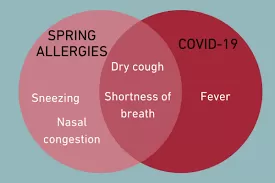
Allergies vs Coronavirus: How to Tell the Difference?
What’s Making You Sneeze? Allergies? Cold?
In the midst of the COVID-19 pandemic, it’s natural to be concerned about any signs or symptoms that may indicate an infection. However, it’s important to remember that not all symptoms are caused by the coronavirus. Allergies, which are common and can occur throughout the year, can sometimes mimic the symptoms of COVID-19. Understanding the differences between allergies and coronavirus symptoms can help you make informed decisions about your health. In this blog post, we will explore the key distinctions and provide guidance on how to tell the difference.
Allergies and Their Symptoms
Allergies are the result of your immune system overreacting to substances in the environment that are usually harmless, such as pollen, dust mites, or pet dander. The most common allergy symptoms include:
- Nasal symptoms: Allergies often cause a runny or stuffy nose, accompanied by frequent sneezing. Itchiness in the nose and throat may also be present.
- Eye symptoms: Allergies can lead to itchy, red, and watery eyes. You may experience a gritty sensation or swelling around the eyes.
- Skin symptoms: Allergic reactions can manifest as skin irritations, such as hives or eczema. Itching and redness are common, and these symptoms may appear in various parts of the body.
It’s worth noting that allergies typically do not cause fever or body aches. If you’re experiencing these symptoms along with the ones mentioned above, it’s important to consider the possibility of a viral infection such as COVID-19.


COVID-19 Symptoms and Indicators
COVID-19 is caused by the novel coronavirus and can present a wide range of symptoms. While some individuals may experience mild or no symptoms at all, others may develop severe respiratory distress. The primary symptoms associated with COVID-19 include:
Fever: A fever is a common symptom of COVID-19. It is often persistent and may be accompanied by chills or sweating.
Respiratory symptoms: COVID-19 can cause a dry cough, shortness of breath, and difficulty breathing. These symptoms are typically more pronounced than those associated with allergies.
Systemic symptoms: The coronavirus can lead to fatigue, body aches, headache, and loss of taste or smell. These symptoms are less commonly associated with allergies.
It’s important to note that COVID-19 symptoms can vary from person to person, and some individuals may exhibit atypical symptoms or experience no symptoms at all. If you have been exposed to someone with COVID-19 or suspect you may have come into contact with the virus, it’s crucial to get tested and follow the guidance of healthcare professionals.
How to Differentiate Allergies from COVID-19
Distinguishing between allergies and COVID-19 can be challenging due to overlapping symptoms. However, there are certain factors that can help you differentiate the two:
- Seasonal patterns: Allergies often follow a predictable seasonal pattern. If your symptoms occur during specific times of the year, such as spring or fall, it’s more likely to be due to allergies rather than COVID-19.
- Contact history: If you have recently been exposed to known allergens, such as pet hair or pollen, and your symptoms coincide with that exposure, it’s more likely to be allergies.
- Severity and progression: Allergy symptoms tend to be milder and develop gradually, whereas COVID-19
Leave a Comment Cancel reply
You must be logged in to post a comment.

